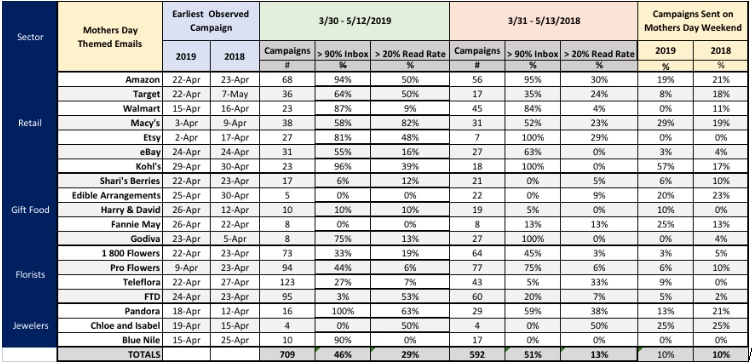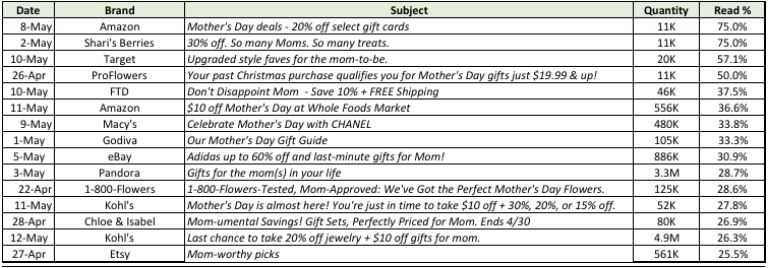To Mom with Love: 2019 Mother’s Day Emails
Our Mother’s Day report for this year provides activity and performance data for nineteen key brands we tracked for this event. These brands represent the retail, gift-food, florist and jewelry sectors.
Key Takeaways
- Start early: There’s evidence that brands whose initial Mother’s Day mailings deployed earlier than three weeks ahead drove somewhat better overall read rates for their Mother’s Day campaigns than brands which started later.
- Get your inbox performance under control: For eight of the tracked brands, less than half of their Mother’s Day campaigns achieved better than 90% deliverability. That’s leaving a lot of money on the table.
- Test targeting previous Christmas season buyers: One brand drove an unusually powerful read rate on a campaign specifically directed (as referenced in its subject line) to customers who’d bought during the previous Holiday selling season.
- Optimize subject lines: Those associated with the strongest campaigns reflected how their audiences had been segmented, and referenced both specific products and a promotional discount offer.
Methodology
For each brand, and for comparable six week periods ending on Mother’s Day in 2019 and 2018, data in the table below show:
- Date of first-observed related campaign
- Number of related campaigns deployed
- The percentage of those campaigns exceeding:
- 90% inbox rates
- 20% read rates
- The percentage of those campaigns deployed during Mother’s Day weekend itself
For example, the table reads as follows: In 2019, Amazon’s first Mother’s Day themed email deployed on April 22, they deployed 68 such emails during the analysis period, 94% of which achieved an inbox rate of 90% or better, 50% drove a read rate of 20% or better, and 19% of which deployed during Mother’s Day weekend itself.

Commentary
- Timing:
- Macy’s, Etsy and ProFlowers were the earliest Mother’s Day mailers, all deploying their first emails with a range of five to six weeks before Mother’s Day. The other brands mostly deployed three to four weeks beforehand. Kohl’s was the latest mailer, with slightly less than two weeks’ lead-time.
- On average, these tracked brands mailed about 10% of their campaigns during Mother’s Day weekend itself. But three brands deployed no related emails that weekend, while Kohl’s deployed 57% of its related emails, and Macy’s, Etsy and Chloe and Isabel invested 25-29% of their Mother’s Day campaigns during that time.
- The four florist brands, along with Amazon, deployed the largest number of Mother’s Day campaigns (within a range of 68-123 apiece). Edible Arrangements, Fannie May, Godiva and Chloe and Isabel anchor the low end of that range (4-8 each).
- Amazon, Etsy, Kohl’s and Godiva had the highest percentage of campaigns achieving inbox rates of 90% of better. Amazon, Macy’s, Etsy and Pandora had the highest percentage of campaigns driving read rates of 20% or better.
- Versus the comparable year-ago period:
- Ten brands mailed more Mother’s Day campaigns, seven brands mailed fewer, and two brands mailed the same number. Overall, the group’s related campaign volume increased by about 20%.
- Seven brands increased the percentage of related campaigns deployed over Mother’s Day weekend, nine decreased and three remained unchanged. For the group this metric remained unchanged.
- As measured in this analysis:
- Inbox performance improved for nine of these brands, eroded for eight, and was unchanged for two. The declines appeared mostly with the Gift-Food and Florists brands. For the group, this deliverability metric declined by five percentage points.
Read rates improved for thirteen of these brands, declined for three, and remained unchanged for three. For the group, this engagement metric increased by thirteen percentage points.
Best Performers
The table below shows fifteen examples of best performing Mother’s Day themed emails, ranked by their read rates. They were taken from a group of 99 related campaigns driving read rates of 25% or higher.
- Most target relatively small audiences, in relation to the respective brands’ estimated overall audience footprint. Four of those drove read rates of 50% or better.
- Seven contain explicitly promotional pricing, including free shipping.
- Seven carry direct product references.
- Of special note:
- ProFlowers’ targeting of a message based on prior Holiday purchase(s).
- FTD’s suggestion of guilt-avoidance in sending flowers to Mom.
- Amazon’s joint promotion of its Whole Foods division in one campaign.
- Five of these (from Target, FTD, Amazon and Kohl’s) deployed during the Mother’s Day weekend, or the day before.










